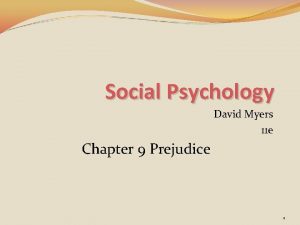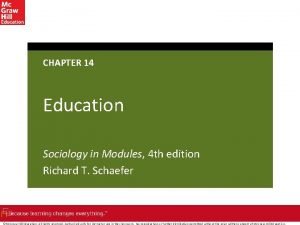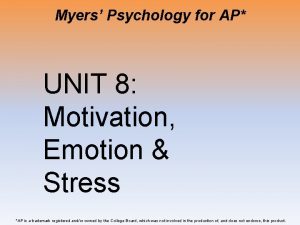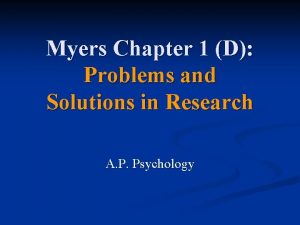EXPLORING PSYCHOLOGY EIGHTH EDITION IN MODULES David Myers













- Slides: 13

EXPLORING PSYCHOLOGY EIGHTH EDITION IN MODULES David Myers Power. Point Slides Aneeq Ahmad Henderson State University Worth Publishers, © 2011

Learning 2

Learning by Observation Module 19 3

Mirrors In the Brain Bandura’s Experiments Applications of Observational Learning § Prosocial Observational Learning § Antisocial Observational Learning 4

Learning by Observation Conditioning principles don’t explain all learning. Higher animals, especially humans, can learn without direct experience, through observational learning, by observing and imitating others. 5

Learning by Observation The monkey on the right imitates the monkey on the left in touching the pictures in a certain order to obtain a reward. We learn all kinds of behaviors through modeling – observing and imitating a specific behavior. 6

Mirror Neurons Neuroscientists discovered mirror neurons – frontal lobe neurons that fire when performing certain actions or when observing another doing so – in the brains of animals and humans that are active during observational learning. PET scans of different brain areas shows that humans have a mirror neuron system that supports empathy and imitation. 7

Learning by observation begins early in life. This 14 -month-old child imitates the adult on TV in pulling a toy apart. Meltzoff, A. N. (1998). Imitation of televised models by infants. Child Development, 59 1221 -1229. Photos Courtesy of A. N. Meltzoff and M. Hanuk. Imitation Onset 8

Bandura's Bobo doll study (1961) indicated that individuals (children) learn through imitating others who receive rewards and punishments. Courtesy of Albert Bandura, Stanford University Bandura's Experiments 9

Applications of Observational Learning Bandura’s studies show that models (family, neighborhood or TV) may have good or bad effects. Businesses use behavior modeling to train communications, sales, and customer service skills. Trainees learn faster when both they are both told and shown skills. 10

Positive Observational Learning Bob Daemmrich/ The Image Works Positive models can have good effects by modeling prosocial (positive, constructive, helpful) behavior. Models are most effective when their words and actions are consistent. 11

Antisocial Observational Learning Observational learning can also have antisocial effects. Television, movies, and video games are a powerful source of observational learning and studies have found a link between viewing violent programs and aggressive behavior – the violence-viewing effect. 12

Antisocial Observational Learning Children modeling after pro wrestlers Glassman/ The Image Works Bob Daemmrich/ The Image Works The violence-viewing effect stems from two factors – imitation and desensitization. 13
 Psychology eighth edition david g myers
Psychology eighth edition david g myers Psychology
Psychology Psychology ninth edition in modules
Psychology ninth edition in modules Psychology ninth edition david g myers
Psychology ninth edition david g myers Psychology tenth edition in modules
Psychology tenth edition in modules Psychology ninth edition in modules
Psychology ninth edition in modules Psychology ninth edition in modules
Psychology ninth edition in modules Social psychology by david myers
Social psychology by david myers Operations management eighth edition
Operations management eighth edition Sociology in modules 4th edition
Sociology in modules 4th edition Myers ap psych unit 8 vocab
Myers ap psych unit 8 vocab Myers psychology for ap
Myers psychology for ap Myers' psychology for ap solutions
Myers' psychology for ap solutions Psychology in everyday life myers
Psychology in everyday life myers

























